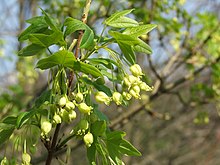bio.wikisort.org - Plant
Acer monspessulanum, the Montpellier maple, is a species of maple native to the Mediterranean region from Morocco and Portugal in the west, to Turkey, Syria, Lebanon, and Israel in the east, and north to the Jura Mountains in France and the Eifel in Germany.[3][4][5]
| Acer monspessulanum | |
|---|---|
 | |
| Foliage | |
Conservation status | |
| Scientific classification | |
| Kingdom: | Plantae |
| Clade: | Tracheophytes |
| Clade: | Angiosperms |
| Clade: | Eudicots |
| Clade: | Rosids |
| Order: | Sapindales |
| Family: | Sapindaceae |
| Genus: | Acer |
| Section: | Acer sect. Acer |
| Series: | Acer ser. Monspessulana |
| Species: | A. monspessulanum |
| Binomial name | |
| Acer monspessulanum | |
 | |
| Distribution map | |
| Synonyms[2] | |
|
List
| |
Description
Acer monspessulanum is a medium-sized deciduous tree or densely branched shrub that grows to a height of 10–15 m (rarely to 20 m).[6] The trunk is up to 75 cm diameter, with smooth, dark grey bark on young trees, becoming finely fissured on old trees. Among similar maples is most easily distinguished by its small three-lobed leaves, 3–6 cm long and 3–7 cm wide, glossy dark green, sometimes a bit leathery, and with a smooth margin, with a 2–5 cm petiole. The leaves fall very late in autumn, typically in November. The flowers are produced in spring, in pendulous, yellow to white corymbs 2–3 cm long. The samaras are 2–3 cm long with rounded nutlets.[4][5]

Subspecies
It is variable, and a number of subspecies and varieties have been described, but few are widely accepted as distinct. The most widely accepted as distinct is Acer monspessulanum subsp. microphyllum (Boiss.) Bornmueller, from Turkey and Lebanon, with smaller leaves not over 3 cm broad.[4]
The species can be mistaken for Acer campestre (field maple), another maple native to Europe, from which it is best distinguished by the clear sap in the leaves (milk-white in field maple), and the much narrower angle between the samara wings.[4][5]
Cultivation
Among maples not endemic to Japan, A. monspessulanum (and the similar A. campestre) are popular among bonsai enthusiasts.[7] In both cases, the smallish leaves and shrubby habit of the maple respond well to techniques to encourage leaf reduction and ramification.[8] These bonsai have an appearance distinct from those created from maples such as Acer palmatum whose leaves are more frilly and translucent.
Otherwise, Acer monspessulanum is rarely seen in cultivation outside of arboreta. In the United States, a mature specimen may be seen at Arnold Arboretum in Boston, Massachusetts. A specimen can also be found in the arboretum of the Montreal Botanical Gardens.
References
- Crowley, D., Rivers, M.C. & Barstow, M. 2018. Acer monspessulanum (errata version published in 2018). The IUCN Red List of Threatened Species 2018: e.T193835A135202094. https://dx.doi.org/10.2305/IUCN.UK.2018-1.RLTS.T193835A124731677.en. Accessed 9 October 2022.
- "Acer monspessulanum L." Plants of the World Online. Board of Trustees of the Royal Botanic Gardens, Kew. 2017. Retrieved 18 November 2020.
- Flora Europaea: Acer monspessulanum
- Rushforth, K. D. (1999). Trees of Britain and Europe. ISBN 0-00-220013-9.
- van Gelderen, C.J. & van Gelderen, D.M. (1999). Maples for Gardens: A Color Encyclopedia.
- (in French)Fleurs de France: Acer monspessulanum
- Bonsai Club International: Acer monspessulanum Archived November 11, 2006, at the Wayback Machine
- Bonsai Club International: Acer campestre Archived November 11, 2006, at the Wayback Machine
External links
 Media related to Acer monspessulanum at Wikimedia Commons
Media related to Acer monspessulanum at Wikimedia Commons- Acer monspessulanum - genetic conservation units and related resources. European Forest Genetic Resources Programme (EUFORGEN)
На других языках
[de] Französischer Ahorn
Der Französische Ahorn (Acer monspessulanum), auch Französischer Maßholder, Felsen-Ahorn oder Burgen-Ahorn genannt, ist eine Baumart aus der Gattung der Ahorne in der Familie der Seifenbaumgewächse.- [en] Acer monspessulanum
[it] Acer monspessulanum
L'acero minore (Acer monspessulanum L.), noto anche come acero trilobo, cestuccio, acero spino, acero di Montpellier, è una specie diffusa nelle aree submontane dei Paesi del Mediterraneo.[ru] Клён трёхлопастный
Клён трёхлопастный (лат. Acer monspessulanum), называемый также монпелийский клён[источник не указан 294 дня], французский клён, скальный клён и замковый клён[источник не указан 294 дня] — вид деревьев рода Клён (Acer) семейства Сапиндовые (Sapindaceae). Естественно произрастает в Средиземноморье от Марокко и Португалии на западе до Турции и Ливана на востоке, на севере доходя до гор Юра во Франции и Айфель в Германии[3][4][5].Другой контент может иметь иную лицензию. Перед использованием материалов сайта WikiSort.org внимательно изучите правила лицензирования конкретных элементов наполнения сайта.
WikiSort.org - проект по пересортировке и дополнению контента Википедии
